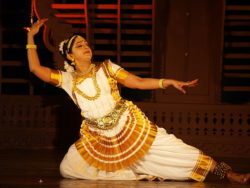Dr. Sunanda Nair became the first in India to acquire a Master’s degree in Mohiniyattam. She completed her Ph.D. thesis in Intrinsic Lyrical Feminism in Mohiniyattam from Mumbai University.
Mohiniyattam is one of the two classical dance forms that originated in Kerala, the other one being Kathakali. Mohiniyattam gets its name from the word ‘Mohini’, the feminine form of Lord Vishnu; the word means ‘dance of Mohini’.

In the art and culture section of the UPSC syllabus, various dance forms including the classical forms are important. Questions can be asked in the IAS prelims on the Indian dance forms, their histories, and other particulars. In this article, you can read all about one of the classical dances of Kerala, Mohiniyattam.
Mohiniyattam – Facts for UPSC Art & Culture
Like most other classical dances of India, Mohiniyattam’s underlying traditions are found in Bharata Muni’s Natya Shastra.
- Mohiniyattam is based on Natya Shastra’s lasya style.
- It has delicate movements and more feminine facial expressions.
- The movements are gentle and glide-like. They do not have terse rhythmic steps.
- More emphasis is on the facial expressions and hand gestures.
- There are features borrowed from other dance forms of Kerala like the Nangyar Koothu and the Thiruvathirakkali.
- It is traditionally performed only by women. Kathakali, on the other hand, was confined to men, although, in the modern times, women also take it up.
- According to some experts, the dance form is 700 years old.
- One of the earliest references of Mohiniyattam is available in Vyavaharamala, which is a 16th century text on Indian jurisprudence authored by Mazhamangalam Narayanan Namboodiri.
- Like many other Indian art forms, Mohiniyattam suffered under the colonial British administration.
- Travancore King Swati Thirunal contributed immensely to the growth and systematisation of the art form.
- Eminent Malayali poet Vallathol Narayana Menon and dancer Kalamandalam Kalyanikutty Amma made tremendous efforts to uplift the dance form.
Historical References to Mohiniyattam
There are sculptures of female dancers in poses similar to those seen in Mohiniyattam found at the 11th century Vishnu temple at Thrikodithanam, Kottayam.
A few texts that find mention of Mohiniyattam:
- Vyavaharamala (16th century)
- Gosha Yatra (17th century)
- Balarama Bharatam (an 18th century treatise on Natya Shastra authored in Sanskrit)
List of Notable Mohiniyattam Dancers in India
- Sunanda Nair
- Kalamandalam Kalyanikutty Amma
- Jayaprabha Menon
- Pallavi Krishnan
- Gopika Varma
- Vijayalakshmi
- Radha Dutta
- Rema Shrikant
Mohiniyattam Costumes
The dancer wears a white or cream plain saree adorned with coloured or gold brocade weaved in its fringes in the typical Kerala style. The artist also wears gold jewellery on her neck, arms, hands, ears, etc.
Mohiniyattam Music
The music accompanying this dance form is based on the Carnatic style.
- The lyrics are in Manipravalam (which is a macaronic language based on Sanskrit and Tamil/Malayalam).
- Instruments used are flute, veena, percussion instruments such as Mridangam, Maddalam, Idakka and Kuzhitalam (cymbals).
- The songs are generally in the Sopana style.
Mohiniyattam UPSC Notes:- Download PDF Here
| Related Links | |||
| Indian Classical Dances | UPSC NCERT Notes for Art & Culture | ||
| Bharatanatyam – UPSC Notes | UPSC Current Affairs | ||
| UPSC Monthly Magazine for Current Affairs | IAS Eligibility | ||

Comments